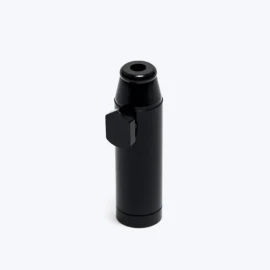Green Gelato Automatic
10,00 €
TL;DR Snapshot / Quick Facts
One-sentence positioning: A dessert‑style, high‑THC autoflower that blends creative sativa lift with a relaxing indica body.
Quick Facts
- Genetics: Thin Mint Cookies × Sunset Sherbet × Cookies Auto (RQS)
- Type: Autoflower (Sativa 55% / Indica 40% / Ruderalis 5%)
- THC: Up to 24% (breeder-tested)
- CBD: Low
- Flowering time: ~70 days from germination
- Indoor yield: Up to 450 g/m²
- Outdoor yield: Up to 100 g/plant
- Height: Compact 80–120 cm
- Difficulty: Beginner-friendly but high potency
Quick callouts: Best for creative daytime use + evening chill; beware potency for novice consumers
Introduction — Why Green Gelato Auto Stands Out
Green Gelato Automatic represents the pinnacle of modern autoflowering genetics, combining the legendary dessert terpene profile of premium Gelato with the convenience and speed of ruderalis genetics. This strain delivers an exceptional balance of potency, flavor, and grow-friendly characteristics that makes it suitable for both novice cultivators and experienced growers seeking premium autoflower genetics.
This comprehensive guide serves first-time autoflower growers looking for quality genetics, advanced cultivators chasing connoisseur-level autos, and medical users seeking analgesic and anti-anxiety effects with a manageable flowering timeline.
Origins & Genetic Lineage
Green Gelato Automatic emerges from carefully selected parent genetics that preserve the essence of the original Gelato while introducing autoflowering capabilities. The foundation begins with the renowned Gelato lineage—a cross between Thin Mint Cookies and Sunset Sherbet—which established the strain’s signature sweet, creamy, and citrusy terpene profile.
The creation of Green Gelato Auto involved crossing this elite photoperiod genetics with Cookies Auto, incorporating stable ruderalis genetics to ensure reliable autoflowering traits. This breeding approach preserved the cake and dessert-like terpene signature while adding autoflowering speed and compact growth characteristics ideal for discrete cultivation.
The genetic influence from Cookie and Sherbet lineages contributes to the strain’s balanced head-and-body effects, while the carefully selected ruderalis genetics ensure consistent flowering regardless of light cycles. This combination results in a strain that maintains premium quality while offering the convenience that modern growers demand.
Official Lab Stats & What They Mean
| Metric | RQS Value | Practical Meaning |
|---|---|---|
| THC | Up to 24% | Potent effects; may be overwhelming for new users |
| Flowering time | ~70 days | Fast turnaround from seed to harvest |
| Indoor yield | Up to 450 g/m² | High productivity for an autoflower |
| Plant height | 80–120 cm | Fits most grow tents and outdoor spaces |
| CBD | Low | Minimal CBD presence; THC-dominant effects |
These statistics represent optimal growing conditions and may vary based on phenotype expression, environmental factors, nutrient programs, and curing methods. Growers should expect some variation within these ranges, with proper cultivation techniques helping achieve results closer to the upper limits.
Aroma, Flavor & Terpene Breakdown
Green Gelato Automatic delivers a complex sensory experience characterized by sweet, citrusy, and earthy notes reminiscent of lemon cream and premium cookies. The strain’s terpene profile creates a distinctive dessert-like aroma that intensifies throughout the flowering cycle.
Key Terpenes and Their Effects:
Limonene: Provides bright citrus notes while contributing to mood elevation and potential anti-anxiety effects. This terpene dominates the initial aroma impression and supports the strain’s uplifting mental effects.
Myrcene: Contributes earthy sweetness and promotes the relaxing body effects that balance the sativa-leaning cerebral experience. Higher myrcene concentrations in some phenotypes enhance the strain’s evening-use potential.
Caryophyllene: Adds subtle spicy undertones while potentially offering anti-inflammatory properties. This terpene bridges the sweet and earthy flavor components.
Linalool: Present in select phenotypes, contributing floral notes and anxiolytic properties that enhance the strain’s therapeutic potential.
Terpene Evolution Through Growth Stages:
During vegetative growth, plants exhibit mild earthy aromas with hints of sweetness. Early flowering brings forward citrus notes, while late flower development intensifies the cream and cookie characteristics. Peak terpene expression occurs during the final 10-14 days before harvest, making proper timing crucial for optimal flavor preservation.
For consumption, vaporizer temperatures between 160–190°C best highlight terpene flavors, while higher temperatures (190–220°C) maximize cannabinoid extraction.
Complete Effects Guide (Recreational & Medicinal)
Recreational Effects Timeline:
Green Gelato Automatic delivers a sophisticated effects profile that begins with immediate cerebral stimulation characteristic of its sativa-leaning genetics. Initial onset brings enhanced creativity, focus, and mild euphoria that supports productive daytime activities or social engagement.
Within 30-45 minutes, the indica influence becomes apparent through gradual body relaxation that doesn’t overwhelm the mental clarity. This progression makes the strain suitable for extended sessions that transition from active engagement to comfortable relaxation.
Average session duration ranges from 2-4 hours, with experienced users reporting sustained effects and minimal tolerance buildup when used moderately.
Medicinal Applications:
User reports suggest effectiveness for several therapeutic applications:
- Pain Relief: The balanced cannabinoid and terpene profile provides both acute and chronic pain management
- Anxiety Reduction: Limonene and potential linalool content support anxiolytic effects without sedation
- Mood Enhancement: Consistent reports of elevated mood and reduced depressive symptoms
- Appetite Stimulation: Moderate munchies effect without overwhelming hunger
Dosage Guidance:
- Novice Users: Start with minimal amounts (0.1-0.25g) due to high THC content
- Regular Users: Standard doses (0.25-0.5g) provide balanced effects
- Experienced Users: Higher doses (0.5g+) maximize both cerebral and body effects
Safety Note: The high THC content requires caution for inexperienced users. Always start low and increase gradually while respecting local cannabis laws.
Beginner’s Grow Plan — Step‑by‑Step Timeline
Pre-Grow Checklist:
- Quality seeds from reputable source
- Growing medium (soil, coco, or hydro setup)
- Containers: 7-20L capacity depending on space
- Lighting: LED or HPS suitable for autoflowers
- Basic nutrients (grow/bloom formulations)
- pH testing and adjustment tools
- Environmental controls (fans, temperature/humidity monitoring)
Week-by-Week Timeline:
Germination (Week 0-1):
- Paper towel method or direct soil planting
- Maintain 20-24°C temperature
- High humidity (70-80%) for optimal sprouting
- Gentle light source or natural light
Seedling Stage (Week 1-2):
- 18-24 hour light schedule
- Minimal feeding (TDS 100-300 ppm)
- Gentle airflow to strengthen stems
- Watch for first true leaves
Vegetative/Early Auto (Week 2-4):
- Establish 18-20 hour light schedule (optimal for autos)
- Begin light stress training (LST)
- Increase feeding gradually
- Monitor for pre-flower signs
Flower Stretch (Week 4-8):
- Watch for rapid height increase
- Switch to flowering nutrients
- Continue LST as needed
- Maintain optimal environment
Late Flower & Flush (Week 8-10+):
- Reduce nitrogen levels
- Monitor trichome development
- Optional flush during final week
- Prepare for harvest
Environmental Targets (Indoor):
Temperature: 20-26°C during day, 18-22°C at night
Humidity: 40-55% (reduce to 35-40% in late flower)
pH: Soil 6.0-6.8, Hydro 5.6-6.2
Lighting: 300-600 µmol/m²/s PPFD, 18/6 schedule recommended
Basic Feeding Schedule:
- Seedling: Low nutrients (TDS 100-300 ppm)
- Vegetative: Balanced NPK with emphasis on nitrogen
- Early Flower: Transition to phosphorus/potassium focus
- Late Flower: High PK, reduced nitrogen
Training and Container Recommendations:
Pot Sizes: 7-11L for indoor cultivation, 11-20L for outdoor growing
Training: LST strongly recommended; avoid topping on autoflowers
Support: Consider plant stakes for heavy branches during flower
Common Beginner Mistakes to Avoid:
- Overwatering during seedling stage
- Heavy training too late in vegetative phase
- Nutrient burn from aggressive feeding
- Harvesting too early or too late
- Inadequate air circulation
Advanced Cultivation: Pro Tips to Maximize Yield & Terpenes
Advanced Training Strategies:
Low Stress Training (LST): Begin gentle bending when plants reach 4-6 nodes. Create an even canopy by tying down main branches and encouraging lateral growth. Continue throughout vegetative growth but ease up during flower stretch.
Micro-Topping Considerations: While generally not recommended for autos, experienced growers may attempt gentle topping at the 4th-5th node if plants show vigorous early growth. Only attempt with healthy, fast-growing specimens.
Screen of Green (ScrOG): Use low screens (30-40cm) to spread branches horizontally. Install screens early and weave branches through as they grow. Remove screens before significant flower development.
Lighting & Environmental Optimization:
High PPFD Management: Advanced growers can push light intensity to 600-800 µmol/m²/s with proper environmental control. Monitor for light stress through leaf positioning and color changes.
CO2 Supplementation: Benefits become apparent at higher light levels (600+ PPFD) in sealed environments. Target 800-1200 ppm during lights-on periods.
Advanced Nutrient Strategies:
Terpene Enhancement Feeding:
- Increase sulfur and magnesium during mid-flower
- Maintain proper potassium levels for oil production
- Include silica supplements for stronger cell structure
- Monitor calcium/magnesium ratios carefully
Late-Flower Stress Techniques:
- Gradual reduction in water frequency
- Slight increase in nutrient concentration
- Controlled drought stress in final weeks
Climate Manipulation for Quality:
Temperature Cycling: Lower night temperatures by 5-8°C during final 3 weeks to enhance terpene retention and potentially trigger color development.
Humidity Control: Reduce relative humidity to 35-40% during final weeks to concentrate essential oils and reduce mold risk.
Advanced Growing Media:
Living Soil Recipe:
- 1/3 high-quality compost
- 1/3 perlite or pumice
- 1/3 peat moss or coco coir
- Amendments: worm castings, kelp meal, bat guano, beneficial mycorrhizae
Hydroponic Optimization:
- Maintain EC levels between 1.2-1.8 throughout cycle
- Adjust feeding frequency based on plant uptake
- Use reverse osmosis water for consistent baseline
Sustainable & Organic Growing Approaches
Living Soil Systems:
Implement no-till practices using organic amendments and beneficial microorganisms. Top-dress with compost and worm castings during vegetative growth, transitioning to high-phosphorus bat guano during flowering. Regular compost tea applications every 10-14 days provide continuous microbial activity.
Water Conservation:
Efficient Watering Systems:
- Drip irrigation for consistent moisture
- Mulching to reduce evaporation
- Fabric pots for improved drainage
- Collection and reuse of runoff water
Organic Pest Management:
Preventive Measures:
- Beneficial insect releases (predatory mites, ladybugs)
- Neem oil applications during vegetative growth
- Bacillus thuringiensis for caterpillar control
- Companion planting with aromatic herbs
Low-Input Nutrition:
Slow-release organic fertilizers reduce feeding frequency while providing steady nutrition. Compost teas, kelp meal, and fish emulsion create complete nutrition programs without synthetic inputs.
Troubleshooting — Common Problems & Fixes
Quick Diagnostic Table:
| Symptom | Likely Cause | Solution |
|---|---|---|
| Yellow lower leaves early | N deficiency or overwatering | Check soil moisture, adjust feeding |
| Brown crispy leaf tips | Nutrient burn | Flush medium, reduce nutrient concentration |
| Drooping leaves | Overwatering or root problems | Improve drainage, reduce watering frequency |
| White powdery spots | Powdery mildew | Increase airflow, reduce humidity, apply organic fungicide |
| Stippled leaves with webbing | Spider mites | Apply miticide, increase humidity, introduce predatory mites |
| Hermaphrodite flowers | Stress or genetics | Remove affected flowers, improve environment |
Advanced Problem Solving:
pH Lockout: Symptoms include multiple deficiencies despite adequate feeding. Solution involves flushing with pH-adjusted water and recalibrating nutrient program.
Light Burn: Upper leaves bleaching or yellowing under intense lighting. Raise lights or reduce intensity, especially during flower development.
Root Bound Plants: Stunted growth in small containers. Transplant carefully or accept reduced yields in current container.
Auto-Specific Issues:
Flowering Stall: Some autos may pause flowering development if stressed. Reduce training intensity and optimize environment to encourage continued development.
Premature Flowering: Very early flowering in small plants indicates stress or genetics. Maintain optimal conditions and accept smaller final size.
Pheno Hunting & Selecting Top Plants
Identifying Superior Phenotypes:
Growth Characteristics:
- Vigorous early growth with tight internodal spacing
- Strong branching with multiple budding sites
- Resistance to environmental stress
- Consistent autoflowering timing
Quality Indicators:
- Heavy resin production visible by week 6
- Intense terpene development
- Dense bud structure with minimal stem
- Healthy green coloration throughout cycle
Expected Phenotype Variations:
Citrus-Dominant Pheno: Bright limonene expression with compact, resinous buds. Typically shows stronger sativa effects and daytime usability.
Cookie-Dominant Pheno: Earthy, sweet aroma with denser bud structure. Usually expresses stronger body effects and evening appeal.
Balanced Pheno: Equal expression of citrus and cookie characteristics with well-rounded effects profile.
Documentation and Selection:
Maintain detailed records for each plant including germination date, growth patterns, nutrient responses, final yield, and qualitative assessments. Photo documentation at key growth stages helps identify superior genetics for future reference.
Harvesting, Drying, Curing & Post‑Harvest Uses
Harvest Timing Guide:
Trichome Assessment:
- Early Harvest (mostly clear trichomes): More cerebral, energetic effects
- Peak Harvest (mostly cloudy trichomes): Balanced effects, maximum potency
- Late Harvest (10-30% amber trichomes): More sedating, body-focused effects
Visual Indicators:
- Pistil color change from white to orange/brown
- Calyx swelling and resin coverage
- Fan leaf yellowing and senescence
Proper Drying Protocol:
Environment Setup:
- Temperature: 18-21°C
- Humidity: 45-55%
- Air circulation without direct airflow on buds
- Complete darkness
Timeline: 7-14 days depending on bud density and environmental conditions. Properly dried buds should have crispy exterior leaves while stems bend but don’t snap.
Curing Process:
Week 1-2: Daily jar opening (burping) for 15-30 minutes to release moisture
Week 3-4: Burp every 2-3 days as moisture stabilizes
Month 2+: Weekly monitoring for optimal flavor development
Target humidity inside jars: 60-62% for optimal curing conditions.
Consumption Methods by Objective:
Flavor Focus:
- Low-temperature vaporizing (160-185°C)
- Solventless extractions (rosin pressing)
- Proper curing for maximum terpene retention
Maximum Potency:
- High-temperature vaporizing (190-220°C)
- Solvent-based extractions (BHO/PHO with proper safety)
- Concentrated forms for medical applications
Extended Effects:
- Decarboxylation for edibles (110°C for 30-45 minutes)
- Ethanol tinctures for controlled dosing
- Infused oils for topical applications
Extraction Guidelines:
Rosin Pressing: Yields 15-25% return with excellent terpene preservation. Press at 80-90°C for 2-3 minutes with gradual pressure increase.
Bubble Hash: Cold water extraction preserves terpenes while concentrating cannabinoids. Use multiple micron bags (220μ, 160μ, 120μ, 73μ) for grade separation.
Safety Note: All extraction methods involving solvents require proper ventilation, safety equipment, and knowledge of local regulations.
Head‑to‑Head Comparisons
Green Gelato Auto vs Photoperiod Green Gelato:
| Characteristic | Auto Version | Photoperiod Version |
|---|---|---|
| Growth Time | 70 days total | 100-120 days total |
| Yield Potential | Up to 450g/m² | Up to 600g/m² |
| Training Options | Limited (LST only) | Full training range |
| Light Schedule | Fixed 18/6 | Flexible control |
| Beginner Friendly | Higher | Moderate |
Comparison with Similar Autos:
vs Gelato Auto (Other Breeders): Green Gelato Auto typically shows more consistent autoflowering traits and better terpene retention.
vs GSC Auto: Similar potency levels but Green Gelato offers more complex flavor profile with enhanced citrus notes.
vs Sunset Sherbet Auto: Green Gelato provides better yield potential while maintaining comparable flavor characteristics.
Grower Profile Recommendations:
Beginner Home Grower: Choose Green Gelato Auto for forgiving genetics and premium results
Stealth Grower: Ideal for compact spaces with controlled height and minimal odor during vegetative growth
Connoisseur: Excellent choice for terpene diversity and high-potency autoflower experience
Community Grow Diaries & Real‑World Metrics
Essential Data Collection:
Environmental Data:
- Tent dimensions and lighting specifications
- Daily temperature and humidity readings
- Nutrient brand, concentration, and feeding schedule
- Training methods and timing
Growth Metrics:
- Weekly height measurements
- Node development tracking
- Flowering transition timing
- Final yield (wet and dry weight)
Community Results Summary:
Typical Indoor Yields: 60-120g per plant in 7-11L containers
Optimal Pot Size: 11L fabric pots show best results for indoor cultivation
Most Successful Training: Early LST combined with selective defoliation
Common Timeline: 68-75 days seed to harvest under optimal conditions
Diary Template Suggestions:
Weekly photo documentation should include full plant shots, close-ups of developing flowers, and trichome development. Note any training performed, environmental changes, and feeding adjustments.
FAQs & Mythbusting
Q: Can Green Gelato Auto really reach 24% THC?
A: Yes, laboratory testing confirms potential for 24% THC under optimal conditions. Home growers typically achieve 18-22% with proper cultivation.
Q: How long does Green Gelato Auto take to flower?
A: Approximately 70 days from germination to harvest, with flowering beginning around week 4-5.
Q: Is topping recommended for autoflowers?
A: Generally no. LST and gentle training produce better results due to autoflowers’ limited recovery time.
Q: Will this strain show purple colors?
A: Some phenotypes may develop purple hues during late flower, especially with cooler night temperatures, but color expression isn’t guaranteed.
Q: Can I grow Green Gelato Auto outdoors in containers?
A: Absolutely. The compact 80-120cm height makes it ideal for balcony cultivation and container growing.
Q: Is this strain suitable for beginners?
A: Yes for cultivation, but the high potency requires caution for new cannabis users. Start with very small amounts.
Common Myths Debunked:
“Autoflowers always yield less than photoperiods”: Modern autoflower genetics can match small photoperiod yields when properly cultivated, with the advantage of faster turnaround.
“You must top autoflowers for good yields”: LST and proper plant care produce better results than high-stress training methods on autoflowering plants.
Sustainable Growing & Legal Considerations
Environmental Responsibility:
Choose organic growing methods when possible, minimize water waste through efficient irrigation, and consider renewable energy sources for indoor cultivation. Proper waste disposal and composting of plant material supports sustainable practices.
Legal Compliance:
Cannabis laws vary significantly by jurisdiction. Ensure full compliance with local regulations regarding cultivation, possession, and consumption. Some areas may restrict autoflowering varieties or have specific licensing requirements.
Safety Protocols:
All extraction and processing activities require proper ventilation, safety equipment, and knowledge of fire safety procedures. Never attempt solvent-based extractions without proper training and safety measures.
Conclusion — Who This Strain Is Best For
Green Gelato Automatic represents an ideal choice for home cultivators seeking premium autoflower genetics that deliver both quality and convenience. This strain particularly suits growers who value fast harvest cycles without compromising on potency or flavor complexity.
Perfect for:
- First-time autoflower growers wanting premium genetics
- Experienced cultivators seeking high-potency autos
- Medical users requiring analgesic and anxiolytic effects
- Space-limited growers needing compact, productive plants
- Connoisseurs appreciating complex terpene profiles
Growing Success Formula: Combine gentle LST training with organic growing methods and careful environmental control during late flower for optimal terpene expression and maximum yield potential.
If you want a fast, compact, dessert-flavored autoflower with clinical-grade THC levels and exceptional terpene expression, Green Gelato Automatic delivers premium results with beginner-friendly cultivation requirements.
Related Products
Frequently Asked Questions
Everything You Need to Know















